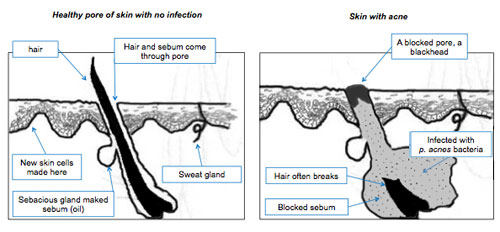Did you know that acne commonly occurs during puberty when the sebaceous (oil) glands come to life - the glands are stimulated by male hormones produced by the adrenal glands of both males and females?
Did you know that Acne is not dangerous, but can leave skin scars?
Did you know that human skin has pores (tiny holes) which connect to oil glands located under the skin?
 Did you know that these glands are connected to the pores via follicles - small canals which produce Sebum, an oily liquid?
Did you know that these glands are connected to the pores via follicles - small canals which produce Sebum, an oily liquid?Did you know that the sebum carries dead skin cells through the follicles to the surface of the skin and a small hair grows through the follicle out of the skin?
Did you know that Pimples grow when these follicles get blocked, resulting in an accumulation of oil under the skin?
Did you know that the word acne comes from the word acme meaning "the highest point", which comes from the Greek akme meaning "point" or "spot" - it was originally mispelt, with an 'n' rather than an 'm' in 1835?
Did you know that in humans, pimples tend to appear on the face, back, chest, shoulders and neck?
 Did you know that these are various types of pimples
Did you know that these are various types of pimples
- Whiteheads - remain under the skin and are very small.
- Blackheads - clearly visible, they are black and appear on the surface of the skin. Remember that a blackhead is not caused by dirt. Scrubbing your face vigorously when you see blackheads will not help.
- Papules - visible on the surface of the skin. They are small bumps, usually pink.
- Pustules - clearly visible on the surface of the skin. They are red at their base and have pus at the top.
- Nobules - clearly visible on the surface of the skin. They are large, solid pimples. They are painful and are embedded deep in the skin.
- Cysts - clearly visible on the surface of the skin. They are painful, and are filled with pus. Cysts can easily cause scars.
Did you know that Dermatologists (skin specialists) say that approximately three-quarters of 11 to 30 year-olds will get acne at some time?
Did you know that acne can affect people of all races and all ages but it most commonly affects adolescents and young adults, although there are people in their fifties who still get acne?

Did you know that the majority of people who get acne will develop mild acne, this can usually be treated with OTC (over-the-counter) medications?
Did you know that OTC medications can be bought at a pharmacy without a doctor's prescription?
Did you know that most acne OTC products may contain the following active ingredients?
- Resorcinol - helps break down blackheads and whiteheads. It is a crystalline phenol and comes from various resins. Resorcinol is also used for treating dandruff, eczema and psoriasis.
- Benzoyl Peroxide - kills bacteria and slows down your glands' production of oil. Benzoyl peroxide is a white crystalline peroxide used in bleaching (flour or oils or fats) and as a catalyst for free radical reactions. It works as a peeling agent, accelerating skin turnover and clearing pores, which in turn reduces the bacterial count in the affected area.
- Salicylic Acid - helps break down blackheads and whiteheads, also reduces shedding of cells which line the follicles of the oil glands, effective in treating inflammation and swelling. Salicylic acid is a white crystalline substance which is also used as a fungicide, or in making aspirin or dyes or perfumes. It causes the epidermis to shed skin more easily, prevents pores from becoming blocked while at the same time allowing room for new cells to grow. It is commonly added to shampoos used for treating dandruff.
- Sulfur - helps break down blackheads and whiteheads. Sulfur, in its native form, is a yellow crystalline solid. Sulfur has been used for centuries for treating acne, psoriasis and eczema. Scientists are not sure how sulfur works to help skin diseases. We do know that elemental sulfur does oxidize slowly to sulfurous acid which is a mild reducing and antibacterial agent.
- Retin-A - helps unplug blocked pores. Retin-A contains Tretinoin, an acid from of vitamin A, also known as all-trans retinoic acid (ATRA). Tretinoin is also used for the treatment of acute promyelocytic leukemia. Retin-A has been used widely to combat aging of the skin, it also acts as a chemical peel.
- Azelaic Acid - strengthens cells that line the follicles, stops oil eruptions, reduces bacteria growth. It is a saturated dicarboxylic acid found naturally in wheat, rye, and barley. Azelaic acid also mops up free radicals, which reduces inflammation. It is useful for patients with darker skin who have dark patches on their face (melasma), or whose acne spots leave persistent brown marks.
Did you know that if you have is more severe you should consider seeing a dermatologist - a skin specialist?
Did you know that a specialist may prescribe a treatment that contains some of the active ingredients mentioned above, such as benzoyl peroxide, azelaic acid, as well as adabalene?

Now if you didn't know, now you know...
To see more did you know that trivia click here


No comments:
Post a Comment